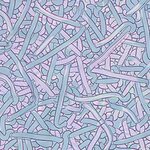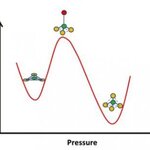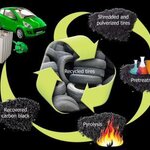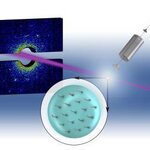Applied Physics

High resolution photograph of cracks in thin layer of glass atop a silicon wafer. The colors come from optical interference between the thin wafer and the glass above. Image credit: Joël Marthelot (ESPCI). Rights information: Used with permission
By: Gabriel Popkin, Inside Science
(Inside Science) -- Repeating crescents, snail shell-like spirals and a jumble of shapes resembling a Keith Haring painting: These patterns and more can start to adorn old paintings, pottery glazes and even electronics under the right conditions. Now, a team of scientists from France and Chile has revealed the…

Glass is ideal for applications that require resistance to thermal shock or to chemically harsh environments and manufacturers commonly use additives such as boron oxide to tweak its properties by changing the atomic structure of glass.
Researchers have captured atoms in borosilicate glass flipping from one structure to another as it's placed under high pressure. Boron oxide is often added to glass to control a range of properties, including chemical durability, flow resistance, optical transparency and thermal expansion. Material scientists know that the structure around the boron…

Bending, stretching, twisting, folding, modern materials that are light, flexible and highly conductive are the future of products like artificial skin or electronic paper.
But these "aerogel monoliths" have required precious gold and silver nanowires, which keeps them squarely in the field of basic research. Making such concepts affordable with copper nanowires and a PVA "nano glue" could be a game-changer, and researchers at Monash University and the Melbourne Centre for Nanofabrication have developed a way.
Despite its conductivity, copper's tendency to oxidation and the…

By Marsha Lewis, Inside Science
(Inside Science TV) – Ever wonder why that cold can of beer you opened heats up so fast? Well, there's a scientific answer behind it…literally.
Atmospheric scientists at the University of Washington have new insights on what makes your beverage lose its cool.
“Condensation really has an impact on your drink," said Dargan Frierson, a mathematician at the University of Washington in Seattle.
The condensation on the outside of a canned beverage doesn't just make it slippery, the drops actually heat it up. To prove it, researchers performed a test inside a 45-year-…

In the 1970s, Florida environmentalists who had invented the notion that landfills were going to overrun America came up with the idea of making coral reefs out of tires. A few short decades later, the clean-up costs when those all came loose were 100X the supposed savings and tires have fallen out of favor as clever quick fixes since then.
Leave it to people in Tennessee to find a new use for old tires. Oak Ridge National Laboratory
researchers have found a way to use them to make better lithium-ion batteries.
By modifying the microstructural characteristics of carbon black, a…

Researchers have devised a new way to separate cells by exposing them to sound waves as they flow through a tiny channel.
Separating cells with sound offers a gentler alternative to existing cell-sorting technologies, which require tagging the cells with chemicals or exposing them to stronger mechanical forces that may damage them.
Their device, about the size of a dime, could be used to detect the extremely rare tumor cells that circulate in cancer patients' blood, helping doctors predict whether a tumor is going to spread.
"Acoustic pressure is very mild and much smaller in terms of forces…

Scientists have mapped quantum tornadoes that swirl within tiny droplets of liquid helium, which confirms that helium nanodroplets are in fact the smallest possible superfluidic objects and opens new avenues to study quantum rotation.
Superfluid helium has long captured scientist's imagination since its discovery in the 1930s. Unlike normal fluids, superfluids have no viscosity, a feature that leads to strange and sometimes unexpected properties such as crawling up the walls of containers or dripping through barriers that contained the liquid before it transitioned to a superfluid.
Helium…

By Peter Gwynne, Inside Science
Why don't we suffocate whenever we try to take a breath? An international team of scientists has used quantum mechanics – the science that usually deals with events at the level of the ultra-small – to solve this human-sized mystery.
Quantum mechanics has long proved its value in understanding such phenomena as the behavior of electrons and in classifying subatomic particles. But in recent years theorists have increasingly shown how it applies to all facets of life, large and small.
The new research, led by Cédric Weber of Kings College, London and reported in…

New measurements of atomic-scale magnetic behavior in iron-based superconductors are challenging conventional wisdom about superconductivity and magnetism.
Superconductivity is strongly suppressed by the presence of long-range magnetism -- where atoms align their magnetic moments over large volumes -- but the ORNL study suggests that rapid fluctuations of local magnetic moments have a different effect. Not only does localized magnetism exist, but it is also correlated with a high critical temperature, the point at which the material becomes superconducting.
The study in Advanced…

The moon is a tranquil place but an article in the Journal of Geophysical Research-Planets suggests that periodic storms of solar energetic particles may have significantly altered the properties of the soil in the moon's coldest craters through the process of sparking - it just took eons.
The article proposes that high-energy particles from uncommon, large solar storms penetrate the moon's frigid, polar regions and electrically charge the soil. The charging may create sparking, or electrostatic breakdown, and this "breakdown weathering" process has possibly changed the very nature of the…